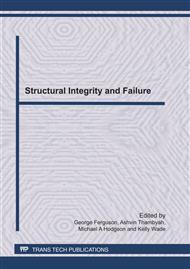p.39
p.43
p.47
p.51
p.55
p.59
p.65
p.69
p.73
An Analysis of the Bonding Energy through Pull-Out Tests for Aerated Concrete with Various Steel Strip Geometries
Abstract:
The relationship between various steel strip geometries and the bonding energy through pull-out tests of aerated concrete specimens is investigated. Prismatic concrete samples containing embedded steel strips with and without holes of differing sizes and quantities were analysed. Improvements of the bonding energy through pull-out tests by 70% are possible by increasing the number of holes on a steel strip from one to four while maintaining a constant surface area. The energy increased even up to 130% for strips containing holes compared to strips without. In addition, the tests have been carried out with a novel easy to assemble set-up containing a freely adjustable ball-joint and a plate with embedded bolts to avoid eccentricity during pull-out tests.
Info:
Periodical:
Pages:
55-58
Citation:
Online since:
July 2011
Authors:
Keywords:
Price:
Сopyright:
© 2011 Trans Tech Publications Ltd. All Rights Reserved
Share:
Citation:


